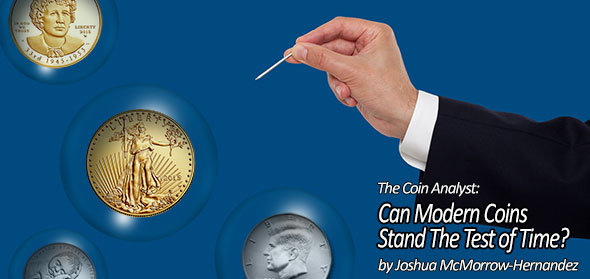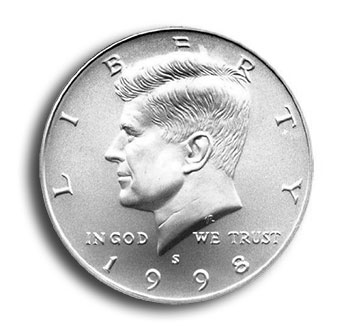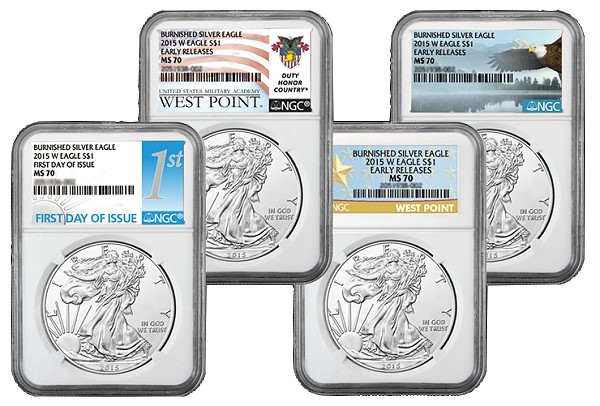
By Joshua McMorrow-Hernandez for CoinWeek….
When it comes to collecting modern coins, Eisenhower dollars, Kennedy half dollars and Lincoln Memorial cents have long proven to be favorites. Year in and year out, these latter-day series (as well as a few others) continue to hold collector interest and are well stocked by coin dealers. They offer an array of dates and die varieties, as well as a small but significant population of tougher issues and high-grade pieces to challenge collectors across the budget spectrum.
So why is it that some modern coins increase in value while others–like, say, certain commemorative issues or even the much-heralded 50 State Quarters series–fall in price within a few years or even months after their original release?
To answer this question, one must understand the law of supply and demand.
Coin pricing depends on persistent interest from the collector. When collector interest in a coin holds and grows over time, it creates a healthy and sustainable market environment. When collectors constantly demand certain coins, dealers tend to keep them in stock. On the other hand, when collectors lose interest in coins, they no longer seek them out, and more often than not, they try to sell them to dealers and other collectors.
This ebb and flow is normal in any collectibles market, and the coin market is no exception.
What is different, however, is that unlike traditional areas of the coin market, the modern market operates on the constant influx of new coins, which are produced for the explicit purpose of being purchased by collectors.
Modern Coin Case Studies: Some Coins Sustain Their Price While Others Flop
 Market demand for new U.S. Mint offerings is almost always hot leading up to and during initial release periods–particularly in the case of products that the market anticipates will be scarce. The recent March of Dimes Special Silver Set is one such example, released amidst great hype on May 4, 2015.
Market demand for new U.S. Mint offerings is almost always hot leading up to and during initial release periods–particularly in the case of products that the market anticipates will be scarce. The recent March of Dimes Special Silver Set is one such example, released amidst great hype on May 4, 2015.
Buyers were most excited not about the March of Dimes silver dollar in the set, but about the 2015-W proof and 2015-P reverse proof Roosevelt dimes exclusive to the product. When the silver coin set was first offered for sale at a price of $61.95, the U.S. Mint implemented a strict ordering limit of five sets per household. Most of the 75,000 proof sets sold out in the first couple days. Within hours of the coins first hitting the market, eager speculators who had bought the proof sets in person at the U.S. Mint’s Washington, D.C. headquarters were already selling their prized acquisitions on eBay for $150.00 or more per set.
As of this writing (September 2015), it seems the coin market has nearly forgotten the springtime hysteria over the March of Dimes Silver Set. Prices on eBay are still above the Mint’s original retail price, but many sets are being offered for “Buy it Now” prices under $90.00, which would have been a bargain just a couple months ago. Will prices continue to slide, or will they stay where they are, perhaps settling in the $75 to $90 range? Only time will tell, but obviously the best chances for any long-term interest in the March of Dimes Special Silver Set lay with the product’s relatively scarce proof dime varieties. However, as long-term market trends continue to show, the Roosevelt dime series is a sleeper that had barely awoken from its slumber when the relatively more affordable (yet still low-mintage) 1996-W Roosevelt dime was offered in U.S. Mint uncirculated sets nearly two decades ago.
Certainly the scenario isn’t all doom and gloom for modern coins. Take, for example, the 1994 and 1997 matte-finish Jefferson nickels, sold in commemorative sets along with the 1993 Thomas Jefferson silver dollar and 1997 Botanic Garden silver dollar, respectively. Both nickels had relatively tiny mintages; 167,703 in 1994 and a mere 25,000 for the 1997 special matte proof nickel. Today, the 1994 Thomas Jefferson Coin and Currency Set sells on eBay for $50 to $75–considerably more than its $39 original issue price. Meanwhile, the 1997 Botanic Garden set, which was originally offered at a pre-sale price of $36 (it sold out within a week of hitting the market), today is offered on eBay for $150 and up.
 The 1998-S matte proof Kennedy half dollar, of which only 62,000 were offered as part of a two-coin set that includes the Robert F. Kennedy commemorative silver dollar, now sells for $225, or around four times the original $59.95 issue price for the two-coin set; prices for the two-coin set hover in the $240 to $250 range.
The 1998-S matte proof Kennedy half dollar, of which only 62,000 were offered as part of a two-coin set that includes the Robert F. Kennedy commemorative silver dollar, now sells for $225, or around four times the original $59.95 issue price for the two-coin set; prices for the two-coin set hover in the $240 to $250 range.
Unlike the Roosevelt dime, however, Jefferson nickels and Kennedy half dollars enjoy much wider appeal among numismatists. Therefore there is a ready collector market for special releases among those series. The previous examples from the 1990s further illustrate how persistent collector demand will buoy prices for modern coins over the long term.
As for the March of Dimes Silver Set thus far, hype affects pricing, and fleeting market frenzy can’t sustain sky-high prices forever. The once-wildly popular 50 States Quarters program provides more examples of what happens to prices when attention subsides. During the early 2000s, when the 50 States Quarters were still in production, the relatively lower-mintage 1999-S and 2001-S 9-coin proof sets were, at one point, selling for more than $75 and $100 each, respectively. The 2008-S proof set was also a hot item a few years ago, fetching as much as $70 when market demand outpaced supply.
But as interest tapered off, so, too, did prices. Even the three aforementioned proof sets, once seen as “key” additions to any proof set collection, can be obtained for $10, $14, and $36 each, with the latter price for the 2008-S proof set still softening as it continues to age into history.
More seasoned collectors may also point to the story of the 1973-S 40-percent silver proof Eisenhower dollar, which saw a relatively small mintage of 1,013,646 pieces. Market speculation and the coin’s perceived rarity drove prices as high as $150 in 1980 and 1981; keep in mind, of course, that this was the era of the Hunt Brothers and $50-per-ounce silver. Under normalized market conditions, the price of the silver clad 1973-S proof Eisenhower dollar fell to below $20 in the late ‘90s. The issue has since rebounded to $45, reflecting renewed interest in the series as collectors and registry set builders realize the scarcity of high-grade Ike dollars.
In other words, as interest in a series ebbs and flows, so too will pricing and its overall market activity.
Long-Time Coin Dealers Sound Off
SilverTowne’s Tony Abel says that while he likes much of the material the U.S. Mint has released in recent years, he has noticed that interest in commemorative coins–classic and modern–has waned.
“There simply is not that much excitement about commemorative coins like there used to be,” he says. “I remember years ago when going to coin shows, there was always a gold coin box and a commemorative coin box. Nowadays, some coin dealers don’t even bring commemorative coins to shows.”
Abel believes one possible reason modern commemoratives have been a tough sell is the sheer number the United States has released in recent years.
“I think the Mint came out with so much stuff that it was hard to keep up,” he remarks. “Years ago, people made a market for commemoratives, but that isn’t the case anymore. It’s hard to buy and make money in the commemorative market,” Abel concludes.
“People aren’t knocking on the door for those coins anymore.”
Similarly, Michael Jacobs at Jake’s Marketplace near Chicago has seen the coin market change since the mid 1960s, when his dad started the family’s long-running coin business.
“It used to be that one series or another was the hottest thing, but now the market has become so fragmented that I no longer see one type of coin leading over another.”
In the case of modern coins, he notices many coin collectors tend to go the topical route.
 “Over the last several years, the number of world governments minting bullion coins and themed coins has grown. Now, we see coin collectors buying sports coins, or bullion pieces that feature certain animals.” He believes that while topical collecting may help ignite the numismatic spark in new hobbyists, it doesn’t necessarily engender interest in a particular series of coins.
“Over the last several years, the number of world governments minting bullion coins and themed coins has grown. Now, we see coin collectors buying sports coins, or bullion pieces that feature certain animals.” He believes that while topical collecting may help ignite the numismatic spark in new hobbyists, it doesn’t necessarily engender interest in a particular series of coins.
That makes it difficult, says Jacobs, for coin dealers to stock other types of modern coins that may not attract the same level of interest but still take up room in shop cases.
“When it comes to supporting a market for the items the U.S. Mint is selling, it is largely a matter of how fast can dealers gobble up supply, how many dealers sell the material, and how many people want to buy it.”
Jacobs reflects that, in the past, a market could be propagated for a certain coin or series based upon whether or not a major numismatic media outlet featured it in a magazine.
“Sometimes the messenger helped create a hype.” He goes on, “that is something I don’t personally see as much of today.”
According to Jacobs, one bright area for modern U.S. coins may be among younger numismatists.
“There is a lot of interest in a coin series such as the American Silver Eagle, which started in an era when many of today’s younger collectors were born or in their early years of coin collecting. It gives these collectors a chance to buy a base set of coins that they can continue building on as new pieces come out each year.”
In addition to the American Silver Eagles, he also sees interest in the gold bullion coin programs.
While bullion prices largely dictate market values for those coins, there is something to be said about the sustained premium on a scarcer bullion issue, such as the uncirculated 1996 American Silver Eagle, which sells for $70 – significantly above the approximately $30 price for similar specimens of more common dates.
Analysts will also point to the 1995 American Eagle Anniversary Set, which has long sold in the secondary market for much more than its original $999 retail price. Today, the five-coin set, which includes West Point proofs of the four gold eagle denominations and the scarce 1995-W proof American Silver Eagle (mintage: 30,125), sells for more than $7,500.
Certainly, prices for the 1995-W proof silver eagle, issued only in the Anniversary Set, stay high given the coin’s low mintage and continued interest for both the American Silver Eagle series and the registry set market, which is largely built around silver eagles.
Will this trend persist? There are plenty of interested buyers for the time being. Coin dealers help keep the secondary market supply chain going, too.
But ultimately, what does it mean for these and other modern coins?
Summing up the situation, Jacobs borrows a quote from his dad.
“He says, ‘this stuff goes through cycles.’”




